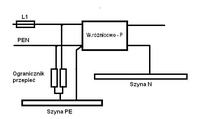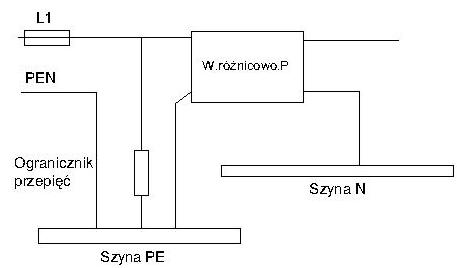Hello!
My friend
Miwhoo first you make a (nonsense) lecture about the role of the RCD in a place where it has no right to be used and then you regret that
Quote: Let's get back to the topic, because it wasn't about RCD ...
It's not fair.
Knowledge of PN HD 60364-4-41 does not apply here, except for one remark in which it prohibits the use of RCDs in the TN-C system.
To understand this issue, it will be more useful to know PBUE, which never allowed (except for special cases not applicable in residential installations) to interrupt the protective-neutral conductor today called PEN. Of course in
justified cases this track had to be interrupted last and switched on first. (Does your colleague uncritically use four-circuit switches today, always and everywhere?)
However, it was rightly assumed that each such connection is a potential failure causing a lack of continuity and thus full voltage on the housing of receivers made in the first protection class.
Do not write only that currents flowed through this wire, because such reasoning sooner or later will lead to a discussion that modern RCDs also interrupt the protective conductor, on which a voltage "dragged" from the outside may also appear.
A device in protection class II does not pose a threat, regardless of the arrangement of the installation that supplies it. A correctly connected class II receiver does not pose such a threat today. This is clear when we compare where the RCD must be used and where it is just an expensive and sometimes even annoying gadget.
Today, RCDs must be used in bathroom circuits, in all socket circuits and probably in tight spaces with surfaces limited by conductive walls.
Why?
Well, because the point here (apart from stationary receivers in bathrooms) is to prevent electric shock in the event of damage to the insulation of such a (portable) receiver. In other words, we accept the injury but do not allow the injury.
And let it stay that way.
Old installations should be liquidated and not resuscitated, dear custodian of the Vistula electrics open-air museum.
What will the RCD give in the final lighting circuits, where a luminaire with protection class II can be used? Do these circuits today, regardless of the protection class of the luminaires, have to be equipped with a residual current device?
No, they don't have to.
Quote: ... PEN disconnection will only be in our part of the installation and nowhere else] in the TN-C system does not pose a threat, and is an effective means of protection.
Not true, because in this case the risk is high, because there may be a situation when a voltage appears on the receiver in the 1st protection class and will be maintained for a long time until the circuit is closed by the human body.
Such nonsense suggestions and, inevitably, the resulting discussions make the brains of young adepts not fully familiar with the principles of electric shock protection. Acting in good faith, they introduce a threat that was not there.
So don't help them idiot by saying no electric shock protection without a residual current device.





